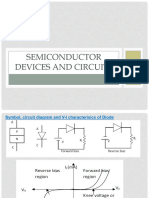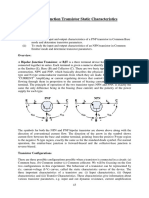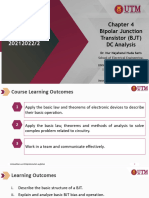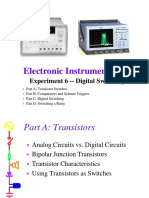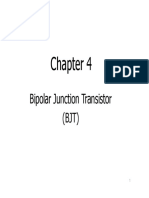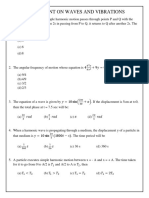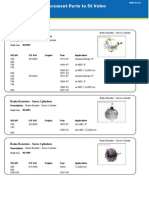Manual BJT
Manual BJT
Uploaded by
Subhadip MaityCopyright:
Available Formats
Manual BJT
Manual BJT
Uploaded by
Subhadip MaityOriginal Description:
Copyright
Available Formats
Share this document
Did you find this document useful?
Is this content inappropriate?
Copyright:
Available Formats
Manual BJT
Manual BJT
Uploaded by
Subhadip MaityCopyright:
Available Formats
JNNCE, Shivamogga ECE
PART-B : Simulation using EDA software
(EDWinXP, PSpice, MultiSim, Proteus, CircuitLab or any equivalent tool)
Experiment No. 1
Input and Output characteristics of BJT Common emitter configuration
and evaluation of parameters.
Aim: Conduct experiment to study the input and output characteristics of an
BJT common emitter configuration and determine transistor parameters.
Components required:
SI No. Particulars Range Quantity
1 Transistor (NPN) Q2N2222 1
2 Resistors 1K 1
100K 1
3 Decade Resistance box 1- 1
4 Bread board - 1
5 Variable power supply (0-30v) 2
6 Voltmeter (0-30v) 1
7 Ammeter (0-200mA) 1
Bipolar Junction Transistor (BJT):
IC IC
C IC C IC
n C p C
+ -
B B B B
p VCE n VCE
IB IB - IB IB - +
+
n p
VBE
- E
VBE + E
E IE E
IE IE
IE
A Bipolar Junction Transistor, or BJT is a three terminal device having two PN-
junctions connected together in series. Each terminal is given a name to identify
it and these are known as the Emitter (E), Base (B) and Collector (C). There
are two basic types of bipolar transistor construction, NPN and PNP, which
basically describes the physical arrangement of the P-type and N-type
semiconductor materials from which they are made. Bipolar Transistors are
"CURRENT" Amplifying or current regulating devices that control the amount of
current flowing through them in proportion to the amount of biasing current
applied to their base terminal. The principle of operation of the two transistor
Electronic Devices and Instrumentation Laboratory
39
JNNCE, Shivamogga ECE
types NPN and PNP, is exactly the same the only difference being in the biasing
(base current) and the polarity of the power supply for each type.
Transistor Configurations:
There are three possible configurations possible when a transistor is connected
in a circuit: (a) Common emitter, (b) Common base, (c) Common collector. We
will be focusing on the first one configuration in this experiment. The behaviour
of a transistor can be represented by dc current-voltage (I-V) curves, called the
static characteristic curves of the device. The three important characteristics of
a transistor are: (i) Input characteristics, (ii) Output characteristics. These
characteristics give information about various transistor parameters, e.g. input
and out dynamic resistance, current amplification factors, etc.
Common Emitter Transistor Characteristics:
In a common emitter configuration, emitter is common to both input and output.
(1) Input Characteristics: The variation of the base current I B with the
base-emitter voltage VBE keeping the collector-emitter voltage VCE fixed,
gives the input characteristic in CE mode.
Input Dynamic Resistance (ri): This is defined as the ratio of change
BE) to the resulting change in base current
B) at constant collector-emitter voltage (VCE). This is dynamic and it
can be seen from the input characteristic, its value varies with the
operating current in the transistor:
(2) Output Characteristics: The variation of the collector current I C with
the collector-emitter voltage VCE is called the output characteristic. The
plot of IC versus VCE for different fixed values of IB gives one output
characteristic. Since the collector current changes with the base current,
there will be different output characteristics corresponding to different
values of IB.
Output Dynamic Resistance (ro): This is defined as the ratio of change
in collector- CE C)
at a constant base current IB.
Common emitter current gain : This is defined as the ratio of the
change in collector current (IC) to the change in base current (IB)at a
constant collector-emitter voltage (VCE) when the transistor is in active
state.
Electronic Devices and Instrumentation Laboratory
40
JNNCE, Shivamogga ECE
Circuit Diagram:
Observations:
Input Characteristics
VCE= 10V VCE= 15V
VBE (V) IB(µA) VBE (V) IB(µA)
Input Characteristics:
IB( A)
VCE=5v
8
10v
7
15v
6
1 IB
VBE
0 VBE(v)
0.2 0.4 0.6 0.8
Calculations:
Dynamic input resistance of transistor in CE configuration
Electronic Devices and Instrumentation Laboratory
41
JNNCE, Shivamogga ECE
Procedure:
1. Now configure CE circuit using the NPN transistor as per the circuit
diagram. Use RB C
2. For input characteristics, first fix the voltage VCE by adjusting VCC to the
minimum possible position like 5V. Now vary the voltage VBE slowly (say,
in steps of 0.5V) by varying VBB and measure VBE. If VCE varies during
measurement bring it back to the set value to determine IB, measure ri.
3. Repeat the above step for another value of VCE say, 10V.
Observations:
Output Characteristics
IB= 50µA IB= 40µA IB=30µA
VCE (V) IC(mA) VCE (V) IC(mA) VCE (V) IC(mA)
Output Characteristics:
IC(mA)
7
Saturation
region Active region
6
5 IC
VCE
4
VCE(v)
-1 0 5 10 15 10
Cutoff region
Electronic Devices and Instrumentation Laboratory
42
JNNCE, Shivamogga ECE
Calculations:
The dynamic output resistance ro and current amplification factor of transistor
in CE configuration:
Procedure:
1. For output characteristics, first fix IB = 10µA, i.e. VBE = 1v. By adjusting
VCC, vary the collector voltage VCE in steps of say 1V and measure VCE
and the corresponding IC using multimeters. If needed vary VCE in and
measure both VCE and IC measure ro.
2. Repeat the above step for at least 5 different values of I B by adjusting
VBB. You may need to adjust VBB continuously during measurement in
order to maintain a constant IB.
3. Plot the input and output characteristics by using the readings taken
above and determine the input and output dynamic resistance. V across
the resistor RB and use the relation IB = VBE/RB.
Result: Dynamic input resistance ri
Dynamic output resistance ro
Common emitter current gain :
Electronic Devices and Instrumentation Laboratory
43
Copy protected with Online-PDF-No-Copy.com
You might also like
- Exp 04Document3 pagesExp 04Captain Jack SparrowNo ratings yet
- BJT CH ApptsDocument5 pagesBJT CH ApptsGOURAV KUMARNo ratings yet
- Experiment 6Document5 pagesExperiment 6Zulqurnan AnjumNo ratings yet
- 3-Transistor Characteristics and Amplifier CircuitsDocument11 pages3-Transistor Characteristics and Amplifier CircuitsJudah SnehanNo ratings yet
- Transistor CharacteristicsDocument6 pagesTransistor Characteristicssumantamurmu945No ratings yet
- 6 Transistor CharacteristicsDocument5 pages6 Transistor CharacteristicsSayan MajiNo ratings yet
- ECE 321/ELE302 Electronics IIDocument79 pagesECE 321/ELE302 Electronics IIJhomie Nero QuistoNo ratings yet
- Bipolar Junction Transistors (BJTS)Document51 pagesBipolar Junction Transistors (BJTS)peprahkofi05No ratings yet
- 5.3 BJT Samll Signal ModelDocument44 pages5.3 BJT Samll Signal ModelfrankelisedwardoNo ratings yet
- BJT Characteristics (Ce Configuration)Document4 pagesBJT Characteristics (Ce Configuration)sasikalaNo ratings yet
- Experiment No: 4-Characteristics of BJT in CE Configuration AimDocument6 pagesExperiment No: 4-Characteristics of BJT in CE Configuration AimGANESH KUMAR B eee201867% (3)
- Experiment II - TRANSISTOR CHARACTERISTICSDocument6 pagesExperiment II - TRANSISTOR CHARACTERISTICSvowjr20No ratings yet
- Exp 03Document3 pagesExp 03Captain Jack SparrowNo ratings yet
- Chapter 5c BJT - EEDocument33 pagesChapter 5c BJT - EEHarithZakariaNo ratings yet
- Edc BJT CeDocument5 pagesEdc BJT CeRavi JaiswalNo ratings yet
- TKE 071208 Week 5 Bipolar-Juction-TransistorDocument19 pagesTKE 071208 Week 5 Bipolar-Juction-TransistorNivika TiffanyNo ratings yet
- 4.DC1 Biasing - BJTsDocument48 pages4.DC1 Biasing - BJTsWaqad HashmiNo ratings yet
- Exp#5: Bipolar Junction Transistor (BJT) DC Characteristics: Eng. Mariam AlfadhliDocument9 pagesExp#5: Bipolar Junction Transistor (BJT) DC Characteristics: Eng. Mariam AlfadhliAyeshaNo ratings yet
- Transistor Characteristic IMS15132 PDFDocument2 pagesTransistor Characteristic IMS15132 PDFabdu0% (1)
- Transistor Characteristic IMS15132Document2 pagesTransistor Characteristic IMS15132abduNo ratings yet
- Transistors and MOSFETDocument28 pagesTransistors and MOSFETUtkarsh ShuklaNo ratings yet
- Lab Exp - 10 CE AmplifierDocument6 pagesLab Exp - 10 CE AmplifierShees NadeemNo ratings yet
- CE AND CB LAB Exp1 2Document7 pagesCE AND CB LAB Exp1 2astridyoungtheoNo ratings yet
- Bjts ppt1Document20 pagesBjts ppt1Nipun chamikaNo ratings yet
- Introduction - Underlying Science: PN JunctionDocument14 pagesIntroduction - Underlying Science: PN JunctionKhuram Shahzad KhalidNo ratings yet
- National Engineering College, Kovilpatti (19EE37C-Analog Electronics Laboratory)Document8 pagesNational Engineering College, Kovilpatti (19EE37C-Analog Electronics Laboratory)MaheswariRVNo ratings yet
- Characteristics of Bipolar Junction TransistorDocument6 pagesCharacteristics of Bipolar Junction Transistor22u211100% (1)
- Transistor ManualDocument13 pagesTransistor ManualSURESH SURAGANINo ratings yet
- 073BEE Lab Sheet 3Document4 pages073BEE Lab Sheet 3bhattaraikushal05No ratings yet
- Experiment 11: NPN BJT Common Emitter CharacteristicsDocument7 pagesExperiment 11: NPN BJT Common Emitter CharacteristicsMalikAlrahabi100% (1)
- BJT Biasing-SowmiyaDocument20 pagesBJT Biasing-Sowmiyavaishu18112004No ratings yet
- 6 - Transistor CharacteristicsDocument8 pages6 - Transistor Characteristicsgetepi7241No ratings yet
- Characteristics of Transistor in Common Emitter ConfigurationDocument14 pagesCharacteristics of Transistor in Common Emitter ConfigurationkishorebabNo ratings yet
- SEEU2012 Electronics Chapter 4 Part 1 BJT DC AnalysisDocument84 pagesSEEU2012 Electronics Chapter 4 Part 1 BJT DC AnalysisRafif IrsyadiNo ratings yet
- 6.BJT CeDocument7 pages6.BJT CeramakrishnadecsNo ratings yet
- Ch04 Bipolar Junction TransistorsDocument42 pagesCh04 Bipolar Junction Transistorsbiruknew45No ratings yet
- Kristin Ackerson, Virginia Tech EE Spring 2002Document20 pagesKristin Ackerson, Virginia Tech EE Spring 2002arpit kumarNo ratings yet
- Module 2 - Bipolar Junction TransistorDocument60 pagesModule 2 - Bipolar Junction TransistorShaurya ShahNo ratings yet
- 2022 2023 Tri 1 EEE1016 Lab Instruction (BE2)Document18 pages2022 2023 Tri 1 EEE1016 Lab Instruction (BE2)j2yshjzzsxNo ratings yet
- ET 212 Electronics: Bipolar Junction TransistorsDocument29 pagesET 212 Electronics: Bipolar Junction TransistorsPaula JaneNo ratings yet
- Electronic Instrumentation: Experiment 6 - Digital SwitchingDocument38 pagesElectronic Instrumentation: Experiment 6 - Digital Switchingganga_chNo ratings yet
- Analog Electronics 5BJT Chars 5BJT CharsDocument5 pagesAnalog Electronics 5BJT Chars 5BJT Charsapi-3723453No ratings yet
- Electronics II - Transistor1Document58 pagesElectronics II - Transistor1Kareem AhmedNo ratings yet
- ACTIVEDocument41 pagesACTIVEandrew MhakaNo ratings yet
- Bipolar Junction Transistor BasicsDocument26 pagesBipolar Junction Transistor BasicssanthoshNo ratings yet
- Chapter 4 - BJTDocument30 pagesChapter 4 - BJTAlwani IzzatiNo ratings yet
- Lab 11: Bipolar Junction Transistor: 1. ObjectivesDocument4 pagesLab 11: Bipolar Junction Transistor: 1. Objectivesمحمد الاكحليNo ratings yet
- BJT Transistor Circuit AnalysisDocument24 pagesBJT Transistor Circuit AnalysisVamshi KrishnaNo ratings yet
- Electronics Experiment 8Document4 pagesElectronics Experiment 8Dulce DeNo ratings yet
- Lecture 4. BJTPPTDocument52 pagesLecture 4. BJTPPTjthanikNo ratings yet
- ELL 100 Introduction To Electrical Engineering:: B J T (BJT)Document68 pagesELL 100 Introduction To Electrical Engineering:: B J T (BJT)vineetha nagahageNo ratings yet
- Electronic Device and Circuits Experiment 5Document6 pagesElectronic Device and Circuits Experiment 5Zulqurnan AnjumNo ratings yet
- ET1006 Chapter 21 Part 1Document30 pagesET1006 Chapter 21 Part 1fastNo ratings yet
- ECE 201 ch3Document56 pagesECE 201 ch3Senay MehariNo ratings yet
- Bme319 Lab2 Can MunganDocument11 pagesBme319 Lab2 Can MunganCan MunganNo ratings yet
- Transistors-1 RevDocument40 pagesTransistors-1 RevChunMan SitNo ratings yet
- Fundamentals of Electronics 1: Electronic Components and Elementary FunctionsFrom EverandFundamentals of Electronics 1: Electronic Components and Elementary FunctionsNo ratings yet
- Design of Electrical Circuits using Engineering Software ToolsFrom EverandDesign of Electrical Circuits using Engineering Software ToolsNo ratings yet
- Manual Jfet and MosfetDocument8 pagesManual Jfet and MosfetSubhadip MaityNo ratings yet
- Digital Signature Process: Signature Generation Signature VerificationDocument5 pagesDigital Signature Process: Signature Generation Signature VerificationSubhadip MaityNo ratings yet
- Application Form ViewDocument2 pagesApplication Form ViewSubhadip MaityNo ratings yet
- Domiciliary Treatment Benefit Claim Discharge Form: Revenue StampDocument1 pageDomiciliary Treatment Benefit Claim Discharge Form: Revenue StampSubhadip MaityNo ratings yet
- Hospital Treatment Form: Anumediclaim PoliciesDocument1 pageHospital Treatment Form: Anumediclaim PoliciesSubhadip MaityNo ratings yet
- Assignment On Waves and Vibrations PDFDocument10 pagesAssignment On Waves and Vibrations PDFSubhadip MaityNo ratings yet
- Circular RuPay Insurance Program 2020 21Document4 pagesCircular RuPay Insurance Program 2020 21Subhadip MaityNo ratings yet
- My - Invoice - 7 Aug 2019, 19:47:38 - 6290528398Document2 pagesMy - Invoice - 7 Aug 2019, 19:47:38 - 6290528398Subhadip MaityNo ratings yet
- 13Document7 pages13Akash PaulNo ratings yet
- General Overview For Students Entering Into The Semister-Wise Three Years Degree Course Under Cbcs (Choice Based Credit System) FOR THE SESSION 2019-2020Document6 pagesGeneral Overview For Students Entering Into The Semister-Wise Three Years Degree Course Under Cbcs (Choice Based Credit System) FOR THE SESSION 2019-2020Subhadip MaityNo ratings yet
- Tbn4 VesselDocument2 pagesTbn4 VesselDarek CzarneckiNo ratings yet
- 1 s2.0 S0021929012004903 MainDocument10 pages1 s2.0 S0021929012004903 MainCoulibaly MaimounaNo ratings yet
- Endangered Animals: by Sai Swananthra 8BDocument7 pagesEndangered Animals: by Sai Swananthra 8BswanNo ratings yet
- Brakes VolvoDocument98 pagesBrakes Volvovanapeer100% (2)
- AnBH Job FileDocument3 pagesAnBH Job FileSimón NataleNo ratings yet
- BIDV Group 8 CIA 1Document21 pagesBIDV Group 8 CIA 1KathirNo ratings yet
- Coloring-Book Ir Abcdirekt C PDFDocument38 pagesColoring-Book Ir Abcdirekt C PDFABCDirekt-IrelandNo ratings yet
- Class 6 Preparation Worksheet Class 7Document2 pagesClass 6 Preparation Worksheet Class 7sextansNo ratings yet
- F43-Obajana Line 3-PM-04 - Clinker ProductionDocument109 pagesF43-Obajana Line 3-PM-04 - Clinker ProductionYhane Hermann BackNo ratings yet
- LG 42pc1r, 42pc1r-Zh Pp62aDocument41 pagesLG 42pc1r, 42pc1r-Zh Pp62aLuděk CsibaNo ratings yet
- Dokumen - Tips Okra Mucilage As Adhesive in Paper RecyclingDocument16 pagesDokumen - Tips Okra Mucilage As Adhesive in Paper RecyclingMiguel TagaroNo ratings yet
- Safety, Operation & Maintenance Manual SMG200Document294 pagesSafety, Operation & Maintenance Manual SMG200horacio suarez vargas100% (1)
- Attachment B - MCHF RFA-004 Budget TemplateDocument3 pagesAttachment B - MCHF RFA-004 Budget TemplatealiwondeellahNo ratings yet
- Reizenstein Technologies RT Has Just Developed A Solar Panel CDocument1 pageReizenstein Technologies RT Has Just Developed A Solar Panel CAmit PandeyNo ratings yet
- Your Electronic Ticket-EMD ReceiptDocument2 pagesYour Electronic Ticket-EMD ReceiptHeddy BugalNo ratings yet
- Battery Systems Engineering 4st5mbfggiDocument2 pagesBattery Systems Engineering 4st5mbfggica23m008No ratings yet
- Group 8Document27 pagesGroup 8Anna ChristineNo ratings yet
- Quadratic EquationsDocument3 pagesQuadratic EquationsamiteejmNo ratings yet
- Sample Questions For Testing Methods Final ExamsDocument5 pagesSample Questions For Testing Methods Final ExamsSSGXCRNo ratings yet
- Valquatight Gasket: Valqua No. 6590 Product Name BLACKTIGHT (Basic Design)Document5 pagesValquatight Gasket: Valqua No. 6590 Product Name BLACKTIGHT (Basic Design)성수길No ratings yet
- Baja Transmission PresentationDocument12 pagesBaja Transmission PresentationBhoomika MansharamaniNo ratings yet
- Toefl Preparation Program:: STRUCTURE Questions: Understanding Subject and VerbDocument19 pagesToefl Preparation Program:: STRUCTURE Questions: Understanding Subject and VerbFebriati RusydaNo ratings yet
- Maxillary SinusDocument67 pagesMaxillary SinusDR. NEETI TATIYANo ratings yet
- J American Geriatrics Society - 2015 - Camilleri - Insights Into The Pathophysiology and Mechanisms of ConstipationDocument9 pagesJ American Geriatrics Society - 2015 - Camilleri - Insights Into The Pathophysiology and Mechanisms of ConstipationHelio JuniorNo ratings yet
- SPMDocument9 pagesSPMRam RajeshNo ratings yet
- Detection of Extra Elements in The Organic CompoundDocument3 pagesDetection of Extra Elements in The Organic CompoundBilNo ratings yet
- Seismic Analysis For Offshore StructuresDocument7 pagesSeismic Analysis For Offshore StructuresBharathiJeganathanNo ratings yet
- Paras Seasons: SECTOR 168, NoidaDocument8 pagesParas Seasons: SECTOR 168, NoidaLila RealtyNo ratings yet
- Direct On Line DOL Motor StarterDocument6 pagesDirect On Line DOL Motor StarterPierre Enrique Carrasco FuentesNo ratings yet
- Diesel 1 - Hoja de Especificaciones - Kta50-G9Document4 pagesDiesel 1 - Hoja de Especificaciones - Kta50-G9Yonny TorradoNo ratings yet




















